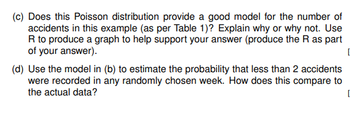The numbers of accidents which occur on an assembly line each week over a 2 year period are summarised in Table 1. Table 1: Number of accidents, 0 1 2 23456780 3 5 6 8 Frequency 1 HNSKO2I2 14 21 36 18 9 1 (a) Use the data to compute the sample mean number of accidents recorded per area. (b) Suppose the data in Table 1 follows a Poisson distribution. Calculate the theoretical Poisson(A = 3) probabilities for integers in the range 0 to 9 inclusive.
The numbers of accidents which occur on an assembly line each week over a 2 year period are summarised in Table 1. Table 1: Number of accidents, 0 1 2 23456780 3 5 6 8 Frequency 1 HNSKO2I2 14 21 36 18 9 1 (a) Use the data to compute the sample mean number of accidents recorded per area. (b) Suppose the data in Table 1 follows a Poisson distribution. Calculate the theoretical Poisson(A = 3) probabilities for integers in the range 0 to 9 inclusive.
A First Course in Probability (10th Edition)
10th Edition
ISBN:9780134753119
Author:Sheldon Ross
Publisher:Sheldon Ross
Chapter1: Combinatorial Analysis
Section: Chapter Questions
Problem 1.1P: a. How many different 7-place license plates are possible if the first 2 places are for letters and...
Related questions
Question

Transcribed Image Text:The numbers of accidents which occur on an assembly line each week over a
2 year period are summarised in Table 1.
Table 1:
Number of accidents, 2
0
1
2
3
4
5
6
8
Frequency
1
14
21
36
18
9
2
1
2
(a) Use the data to compute the sample mean number of accidents recorded
per area.
(b) Suppose the data in Table 1 follows a Poisson distribution. Calculate the
theoretical Poisson (A = 3) probabilities for integers in the range 0 to 9
inclusive.
Expert Solution
This question has been solved!
Explore an expertly crafted, step-by-step solution for a thorough understanding of key concepts.
Step by step
Solved in 4 steps

Follow-up Questions
Read through expert solutions to related follow-up questions below.
Follow-up Question

Transcribed Image Text:(c) Does this Poisson distribution provide a good model for the number of
accidents in this example (as per Table 1)? Explain why or why not. Use
R to produce a graph to help support your answer (produce the R as part
of your answer).
[
(d) Use the model in (b) to estimate the probability that less than 2 accidents
were recorded in any randomly chosen week. How does this compare to
the actual data?
Solution
Recommended textbooks for you

A First Course in Probability (10th Edition)
Probability
ISBN:
9780134753119
Author:
Sheldon Ross
Publisher:
PEARSON


A First Course in Probability (10th Edition)
Probability
ISBN:
9780134753119
Author:
Sheldon Ross
Publisher:
PEARSON
